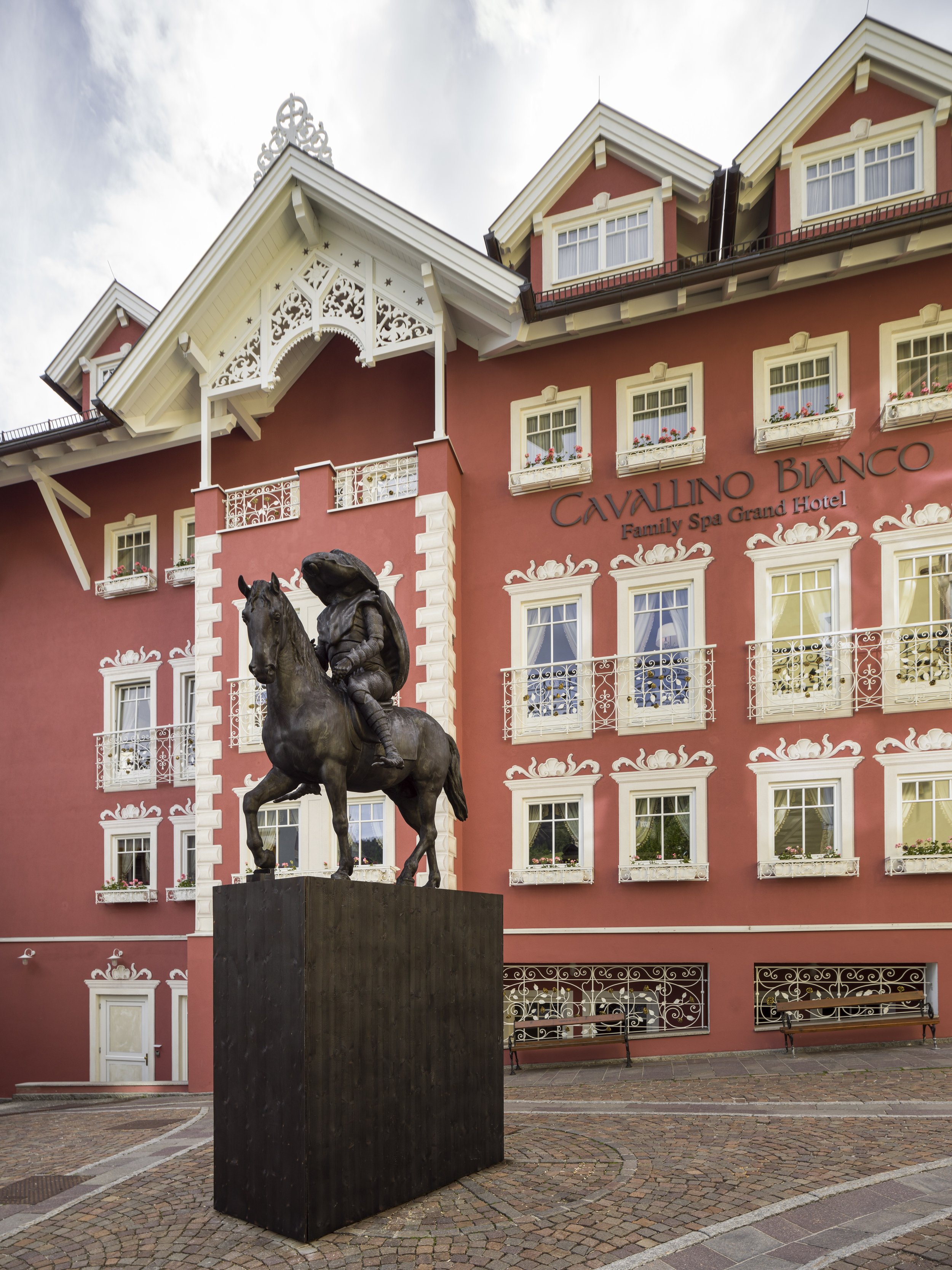
Julius von Bismarck, Beatle On A Horse, 2024. Stone Pine Wood. 444 x 125 x 233 cm. Commissioned by Biennale Gherdëina 9. Supported by IFA - Institut für Auslandsbeziehungen. Photo by Tiberio Sorvillo

Julius von Bismarck, Beatle On A Horse, 2024. Stone Pine Wood. 444 x 125 x 233 cm. Commissioned by Biennale Gherdëina 9. Supported by IFA - Institut für Auslandsbeziehungen. Photo by Tiberio Sorvillo

Julius von Bismarck, Beatle On A Horse, 2024. Stone Pine Wood. 444 x 125 x 233 cm. Commissioned by Biennale Gherdëina 9. Supported by IFA - Institut für Auslandsbeziehungen. Photo by Tiberio Sorvillo
Julius von Bismarck
1983, Breisach am Rhein, Germany
EN In his works, Julius von Bismarck investigates the notion of nature as cultural product and social fiction. His research is intertwined with scientific research and takes on various forms: from sculpture to photography, and from installations to performance action videos. In one of his most recent works –TheElephant in the Room(2023) – the artist juxtaposes an equestrian monument dedicated to Otto von Bismarck (the replica of a public sculpture in Bremen) with a taxidermised giraffe, each placed on a pedestal. Unexpectedly, both statues collapse in on themselves, disarticulating until they almost fall over, only tore assemble and become whole again. The project literally and conceptually deconstructs the idea of the monument, focusing on two opposing mythologies:that of German history and that of nature read through the lens of exoticism.ForThe Parliament of Marmots, von Bismarck designed a new equestrian statue, installed in the centre of Ortisei. Proudly riding the horse, instead of a victorious warrior there is a bark beetle: a small local beetle that, due to global warming and human (in)action, has infested the forests of the Dolomites in recent years, leading to the disappearance of entire woodland areas. Depicting the insect as a conqueror, with the bark beetle on horseback the artist questions humans as one of the greatest plagues to their own environment.
IT Nelle sue opere Julius von Bismarck indaga l‘idea di natura come prodotto culturale e finzione sociale.La sua ricerca è legata a doppio filo con la ricerca scientifica e prende varie forme: dalle sculture alle fotografie, dalle installazioni ai video di azioni performative. In uno dei suoi lavori più recenti,The Elephant in the Room(2023), l’artista ha affiancato un monumento equestre dedicato a Otto von Bismarck, replica di una scultura pubblica a Brema, a una giraffa tassidermizzata, ognuno posizionato su un piedistallo. Inaspettatamente entrambe le statue collassano su se stesse, disarticolandosi fino a quasi cadere, per poi ricomporsi e tornare intere. Il progetto decostruisce letteralmente e concettualmente l’idea di monumento, focalizzandosi su due opposte mitologie:quella della storia della Germania e quella della natura letta attraverso la lente dell’esotismo. PerThe Parliament of Marmots von Bismarck ha ideato una nuova statua equestre, installata nel centro di Ortisei. In sella al cavallo, al posto di un guerriero vittorioso, cavalca fiero un bostrico, un piccolo coleottero presente in natura che, a causa del riscaldamento globale e dell’(in)azione dell’essere umano, negli ultimi anni ha infestato le foreste delle Dolomiti, provocando la scomparsa di aree boschive. Rappresentando l’insetto come un conquistatore, con il bostrico a cavallo l’artista si interroga sugli umani come una delle più grandi piaghe per il loro stesso ambiente.
DE In seinen Arbeiten untersucht Julius von Bismarck die Idee der Natur als kulturelles Erzeugnis und soziale Fiktion.Seine Recherchen sind untrennbar mit der wissenschaftlichen Forschung verbunden, und nehmen verschiedeneFormen an: von Skulpturen bis zu Fotografien, von Installationen bis zu Videos zu performativen Aktionen. In einer seiner jüngsten Arbeit -The Elephant in theRoom(2023) - hat der Künstler ein Reiterdenkmal von Otto von Bismarck, - eineNachbildung einer öffentlichen Skulptur in Bremen, - einer präparierten Giraffe gegenübergestellt, die beide auf einem Sockel stehen. Unerwartet fallen beideStatuen in sich zusammen, zerlegen sich, bis sie fast umfallen, um sich anschließend wieder zu einer ganzen Skulptur zusammenzusetzen. Das Projekt dekonstruiert buchstäblich und konzeptuell die Idee des Denkmals und konzentriert sich auf zweigegensätzliche Mythologien: jene der deutschen Geschichte und jene der durch die Linse des Exotismus gelesenen Natur. FürThe Parliament of Marmots entwarf von Bismarck ein neues Reiterstandbild, das im Zentrum von St. Ulrich aufgestellt wurde. Statt eines siegreichen Kriegers reitet ein stolzer Borkenkäfer im Sattel, ein kleiner, in der Natur vorkommender Schädling, der aufgrund der globalenErwärmung und menschlicher (Un-)Tätigkeit in den letzten Jahren die Wälder der Dolomiten heimgesucht und das Absterben ganzer Waldgebiete verursachthat. Indem er das Insekt als Eroberer darstellt, thematisiert der Künstler mit dem reitenden Borkenkäfer den Menschen als eine der größten Plagen für seine eigene Umwelt.
EN Te si opres ti va Julius von Bismarck do al’idea de natura coche prodotculturel y finta soziela. Si nrescida ie lieda cun doi fii ala nrescida scientifica ygiapa formes defrëntes: dala scultures ala fotografies, dala nstalazions ai video deperformance. Te un de si lëures plu jëuni -The Elephant in the Room(2023) – àl artist metù daujin n monumënt cun Otto von Bismarck a ciaval, replica de nascultura publica a Bremen, y na girafa stafuneda ora, tramedoi sun n pustamënt.Zënza se l aspité toma tramedoi statues nsëuralauter, se deslieia y toma belau perpona se mëter inò adum y vester ntieres. L proiet tol ndalauter leteralmënter yaldò dl cunzet l’idea de monumënt y se cunzentrea sun doi mitologies cuntreres:chëla dla storia dl Deutschland y chëla dla natura ududa tres l udon dl esotism.PerThe Parliament of Marmotsà von Bismarck metù ora na statua nueva cunn ciaval che ie da udëi tl zënter de Urtijëi. A ciaval va, mpede n cumbatënt che àvenciù, cun ardimënt n chëifer dala scorza, n pitl chëifer che ie tla natura, che pergauja dl sciaudamënt sëura dut l mond y dla azion (y nia) dla persona à nfestà ibòsc dla Dolomites y à fat scumparì de gran raions da bosch. L mostra l nset cocheun che tol ite, tres l chëifer dla scorza a ciaval se fej l artist la dumanda sce la persones ie una dla majera pëines per si ambient.